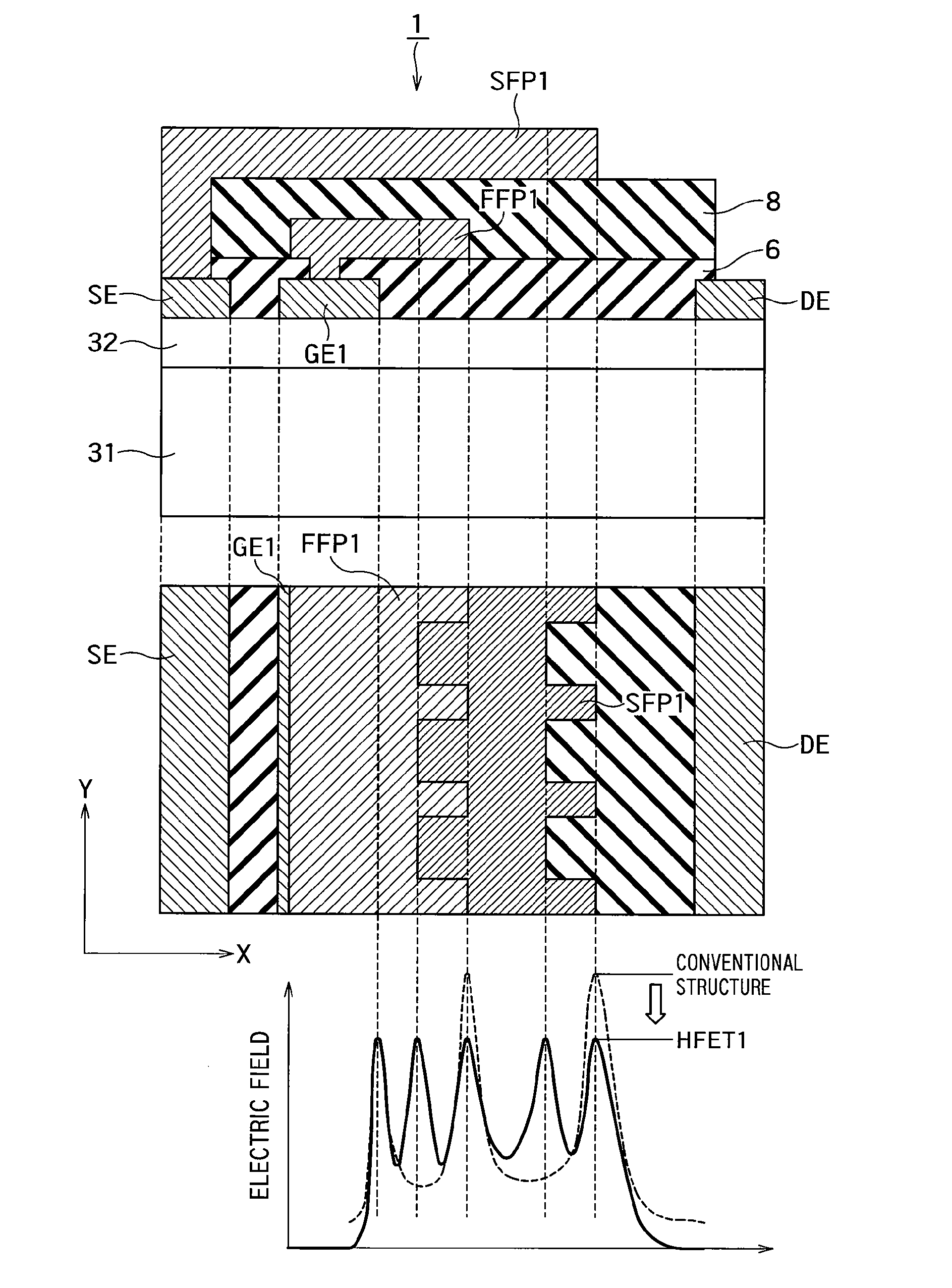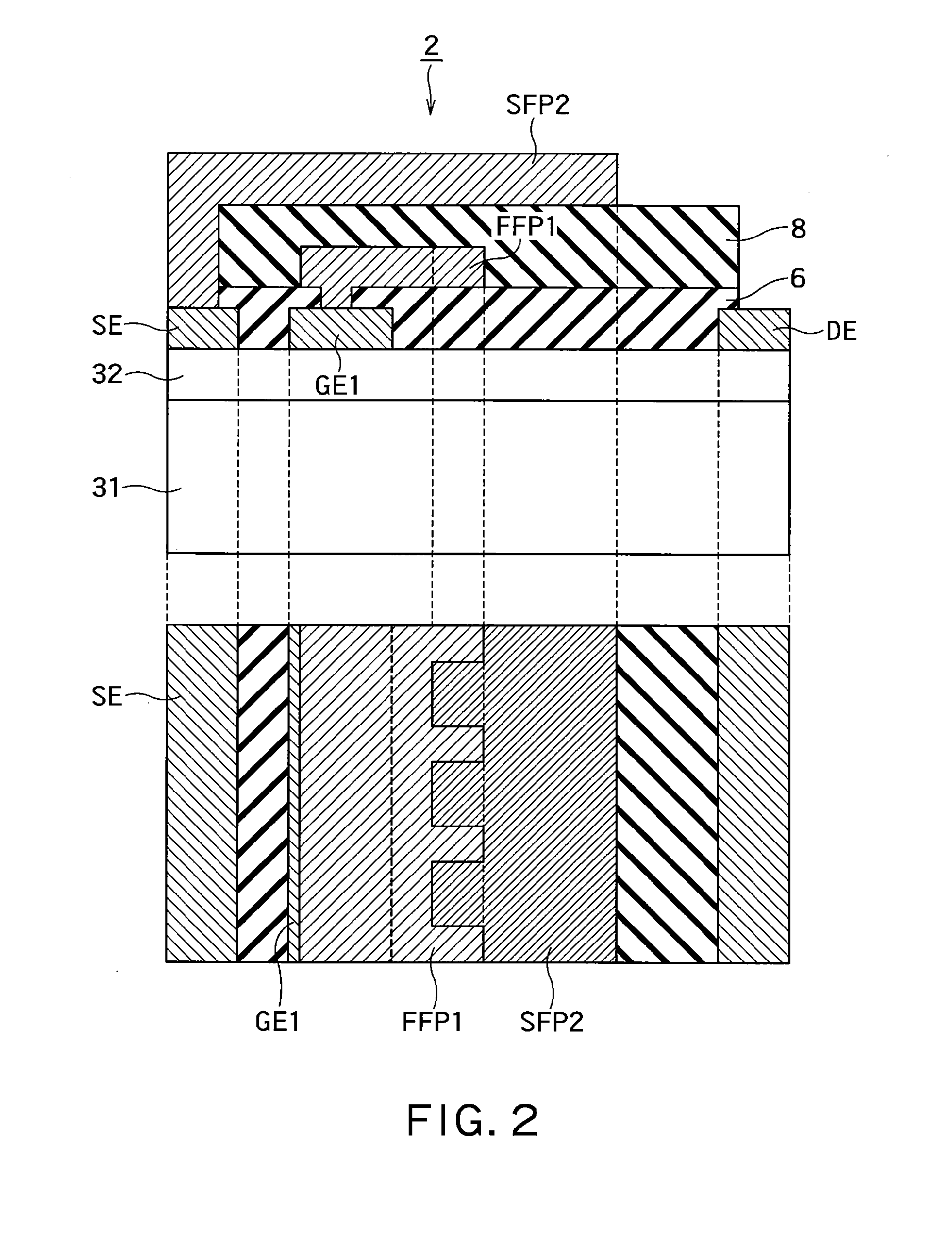Semiconductor device
a technology of semiconductors and devices, applied in the direction of semiconductor devices, basic electric elements, electrical equipment, etc., can solve the problems of generating crystal defects, affecting the reliability of elements, and fluctuating properties,
- Summary
- Abstract
- Description
- Claims
- Application Information
AI Technical Summary
Problems solved by technology
Method used
Image
Examples
first embodiment
[0033]FIG. 1 shows the outlined constitution of a GaN-HFET according to the first embodiment of the present invention.
[0034]As shown in an outlined cross-sectional view at the upper part in FIG. 1, a GaN-HFET1 in the present embodiment includes a channel layer 31, a barrier layer 32, a source electrode SE, a drain electrode DE, a gate electrode GE1, insulating films 6 and 8, and field plate electrodes FFP1 and SFP1.
[0035]The channel layer 31 is formed of a non-doped GaN layer and corresponds to, for example, a first semiconductor layer in the present embodiment. The barrier layer 32 is formed of a non-doped AlGaN layer on the channel layer 31 and corresponds to, for example, a second semiconductor layer in the present embodiment. The gate electrode GE1 is formed on the barrier layer 32 in such a manner as to provide a Schottky contact between itself and the barrier layer 32. The gate electrode GE1 corresponds to, for example, a first electrode in the present embodiment. The source e...
second embodiment
(2) Second Embodiment
[0045]FIG. 5 shows the outlined constitution of a GaN-HFET according to the second embodiment of the present invention. The second through sixth embodiments will be described only on their differences from the first embodiment.
[0046]As may be clear from comparison to FIG. 1, a first feature of a GaN-HFET4 in the present embodiment is that the amount of the change “e” in length of the field plate electrode FFP1 is smaller than the amount of the change “f” in length of a field plate electrode SFP4 (e1 and SFP4, a more relaxed electric field distribution can be obtained.
[0047]Further, a second feature of a GaN-HFET4 is that the total sum “h” of the thicknesses of insulating films 6 and 8 under the field plate electrode SFP4 is larger than the thickness “g” of the insulating film 6 under the field plate electrode FFP1 (g1 and SFP4, the peak of the electric field can be lowered further. Preferably, a ratio e / f of the changes in length between the field plate electrod...
third embodiment
(3) Third Embodiment
[0048]FIG. 7 shows the outlined constitution of a GaN-HFET according to a third embodiment of the present invention.
[0049]As may be clear from comparison to FIG. 5, the feature of a GaN-HFET6 in the present embodiment is that X-directional lengths of the respective field plate electrodes FFP1 and SFP6 change in a period common to them but in phases different from each other. By using such a structure, an electric field is securely concentrated on dispersed positions, so that its peak can be lowered further. Although FIG. 7 has shown such a structure that one phase might shift by half the other period, the present invention is not limited to it; for example, almost the same effects can be obtained as long as one phase shifts even by the quarter of the other period.
PUM
 Login to View More
Login to View More Abstract
Description
Claims
Application Information
 Login to View More
Login to View More - R&D
- Intellectual Property
- Life Sciences
- Materials
- Tech Scout
- Unparalleled Data Quality
- Higher Quality Content
- 60% Fewer Hallucinations
Browse by: Latest US Patents, China's latest patents, Technical Efficacy Thesaurus, Application Domain, Technology Topic, Popular Technical Reports.
© 2025 PatSnap. All rights reserved.Legal|Privacy policy|Modern Slavery Act Transparency Statement|Sitemap|About US| Contact US: help@patsnap.com



